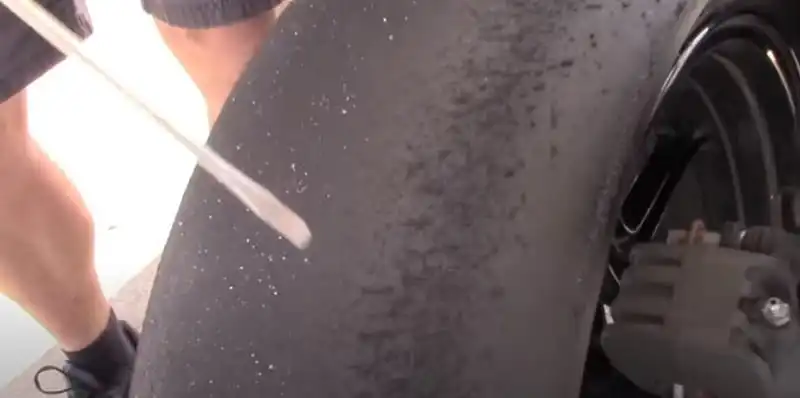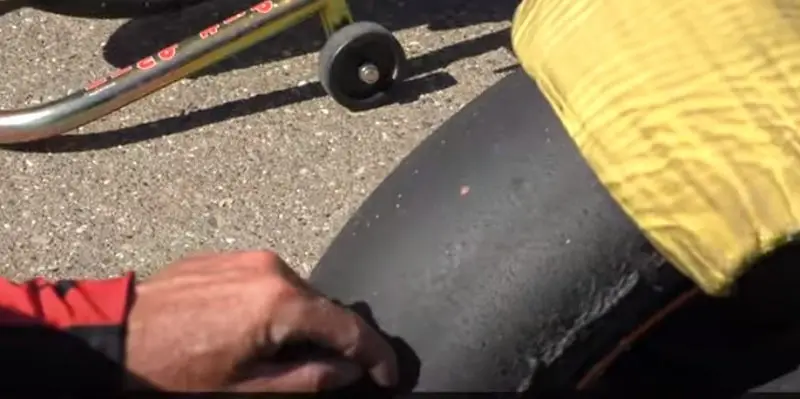Have you ever watched a MotoGP race and noticed that the motorcycle tires look smooth, almost like they don’t have any tread?
It’s a question that might have crossed your mind, especially if you’re familiar with other types of racing tires that typically have a more aggressive tread pattern.
So why do MotoGP motorcycle tires look so smooth? Is it a design flaw, or is there a reason for their smooth appearance?
MotoGP motorcycle tires look smooth because they are designed to maximize the amount of rubber that has contact with the ground once they come up to the right temperature, providing greater capacity to grip.
The design of MotoGP motorcycle tires is a secret of the racing series, and riders are provided with harder and softer tires and tires suitable for wet and dry conditions.
After tires have been used to the point where they gain significant heat, a smooth surface is created on the tire’s surface when they cool down again.
This helps prevent the tire from buckling under a high side load when riders use a carcass style.
In this post, we’ll delve into the world of MotoGP motorcycle tires to uncover the reasons behind their smooth appearance and how they are designed to perform at the highest level of motorcycle racing.

The Role of Temperature in Motogp Tire Design
Temperature is an important factor to consider when designing tires for MotoGP racing. A tire’s performance is largely dependent on its temperature, as the heat generated by the tire’s contact with the ground can affect its grip, durability, and overall performance.
In general, softer tires offer more grip at lower temperatures, while harder tires are better suited for higher temperatures.
This is because the softer the tire, the more it will deform under load, creating a larger contact patch with the ground and providing more grip.
However, softer tires can also wear out more quickly, especially at higher temperatures.
To ensure that MotoGP tires perform at their best within a specific temperature range, tire manufacturers use a variety of compounds and construction techniques to create tires that offer the optimal balance of grip and durability.
In addition, these tires are carefully designed to perform at their best within a specific temperature range, depending on the specific requirements of the track and the expected weather conditions.
In cold weather, it is common for MotoGP teams to use softer tires, as they offer better grip at lower temperatures.
However, it’s important to note that using the wrong tires at the wrong moment can help performance, as the tires may need help to handle the heat generated by the bike’s high speeds.
As such, it is important for riders to carefully consider the expected track and weather conditions when choosing their tires.
The Importance of Grip in Motogp Racing

The grip is essential for motorcycle performance, as it determines how well the motorcycle can transfer power to the ground and how well it can corner and brake.
In MotoGP racing, where the bikes can reach speeds over 200 mph, the grip is of the utmost importance.
MotoGP tires are designed to ensure maximum grip with a range of conditions in mind. These tires are typically made from various compounds and construction techniques to provide the optimal balance of grip, durability, and performance.
In wet conditions, using carbon fiber brakes can help improve grip by dissipating heat more effectively than traditional steel brakes.
Carbon fiber brakes can also provide better bite and modulation, allowing the rider to brake more effectively in wet conditions.
In addition to the use of specialized compounds and construction techniques, a tire’s tread pattern can also play a role in its grip.
While MotoGP tires may appear smooth, they have a subtle tread pattern designed to evacuate water and improve grip in wet conditions. This helps to prevent hydroplaning and maintain traction on the track.
Overall, the importance of grip in MotoGP racing cannot be overstated. With a good grip, a rider’s ability to corner, brake, and accelerate is maintained, which can significantly impact their track performance.
The Benefits of Soft Motogp Tires
Soft MotoGP tires offer several benefits in certain conditions. One of the main advantages of soft tires is their ability to provide maximum grip at lower temperatures.
In addition, because they are softer, they can deform more under load, creating a larger contact patch with the ground and providing more grip. This is especially useful in cold weather, when the track surface may be colder and less grippy.
Another benefit of soft tires is that they enable riders to push their bikes to the limit. In addition, because they offer more grip, riders can corner harder and brake later, which can help to improve lap times.
However, it’s important to note that soft tires also have some potential drawbacks. One of the main issues with soft tires is that they can wear out more quickly, especially at higher temperatures.
This can be a problem during long races or if the track surface is abrasive. In addition, soft tires may offer a different level of stability and support than harder tires, making it more difficult for riders to control their bikes at high speeds.
In summary, soft MotoGP tires offer several benefits. Still, it’s important for riders to carefully consider the expected track and weather conditions before making a decision on which tires to use.
FAQ
What are MotoGP motorcycle tires made of?
MotoGP motorcycle tires are typically made from compounds and construction techniques designed to provide the optimal balance of grip, durability, and performance.
These compounds and techniques can vary depending on the specific requirements of the track and the expected weather conditions.
What are the drawbacks of using soft tires?
The main drawback of soft tires is that they can wear out more quickly, especially at higher temperatures.
This can be a problem during long races or if the track surface is abrasive. In addition, soft tires may offer a different level of stability and support than harder tires, making it more difficult for riders to control their bikes at high speeds.
In Conclusion
In conclusion, the smooth appearance of MotoGP motorcycle tires is not a design flaw but rather a result of their specific design and the conditions they are meant to handle.
Temperature is an important factor in MotoGP tire design, and tires are carefully formulated and constructed to perform at their best within a specific temperature range.
Furthermore, grip is essential in MotoGP racing, and tires are designed to provide maximum grip in various conditions, including wet conditions.
Soft tires offer several benefits, including better grip at lower temperatures helping riders push their bikes to the limit.
However, they also have potential drawbacks, such as quicker wear and reduced stability at high speeds.
Ultimately, the tire choice for a MotoGP race depends on the specific track and weather conditions, and riders must carefully consider these factors when deciding.
Previous Article: Why Does the Speed Rating on Motorcycle Tires Matter?
Next Article: Why Are Motorcycle Tires Curved?